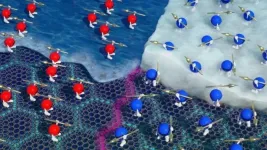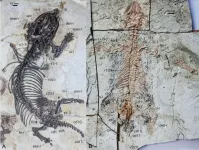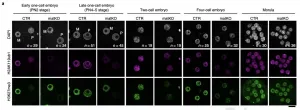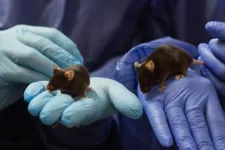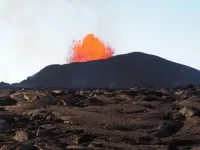Anticoagulation and cerebral small vessel disease
What really causes intracerebral haemorrhage
2021-04-07
(Press-News.org) Cardiovascular diseases are usually complex and affect multiple organs simultaneously. Treatments for vascular diseases in the brain may therefore have implications for the treatment of cardiac diseases. It is therefore important to understand the respective causes and effects. This study explores the causes of intracerebral haemorrhages and links them to the risk of stroke associated with atrial fibrillation. It suggests a fundamental new assessment of the effects of blood thinning on intracerebral haemorrhages.
About 1,000 patients with intracerebral haemorrhage are treated at stroke units each year in Switzerland. Intracerebral haemorrhages are more often fatal than other forms of strokes, and their incidence has not decreased in the past 30 years. The use of blood thinners was previously considered not only to be a risk factor but potential cause for a intracerebral haemorrhage.
Anticoagulation should not be regarded as primary cause
This publication includes the results of two studies conducted by the team of Prof. Werring. It contrasts the role of blood thinning with that of cerebral small vessel disease (SVD) in intracerebral haemorrhages. A moderate to severe cerebral SVD is shown to be closely associated with the occurrence of cerebral haemorrhages. Dr David Seiffge summarized the results as follows: "Our results show that SVD is a precondition for intracerebral haemorrhages under anticoagulation. The degree of SVD in the brain may be used to predict intracerebral haemorrhages. Without SVD the occurrence of intracerebral haemorrhage is close to zero. Consequently, anticoagulation should no longer be considered a cause of intracerebral haemorrhages."
Why is this important? Protection against stroke for patients with atrial fibrillation
Blood thinning offers important protection against ischemic stroke in patients with atrial fibrillation. Anticoagulation reduces the risk of ischemic stroke in these cases by two-thirds. In the past, anticoagulation has been discontinued immediately in the event of an intracerebral haemorrhage and patients were left unprotected against the risk of a stroke. The new study results now point to a new path: according to the findings, intracerebral haemorrhages can be prevented etiologically by treating cerebral SVD and protection against stroke can be maintained through an adapted continuation of blood thinning. The exact timing and gradation of the two therapies are the subject of further studies.
A challenging methodological approach: combining two multicentre studies
The publication comprises data originating from two independent studies supervised by Prof. David Werring, UCL.The publication is based on two independent, multicentre observational studies. First, a cross-sectional study was carried out with 1,030 patients with intracerebral haemorrhages. CT and MRI were used to look for markers of SVD in the brain. 1,447 patients with atrial fibrillation and cerebral circulatory disorders were enrolled in a second, prospective study. In this group, the incidence of cerebral haemorrhages and ischaemic stroke was considered in relation to blood thinning.
Using this approach, it was possible to show that SVD is a prerequisite for intracerebral haemorrhage. Patients without such a condition did not have a single brain haemorrhage within the first 2 years in the study, despite being treated with a blood thinner. In contrast, at 1.56% per year, the risk was significantly increased for moderate to severe SVD.
A new way of looking at the situation is needed
The study results suggest that blood thinning alone can no longer be considered a cause of intracerebral haemorrhages. Prof. Marcel Arnold points out: «As a new approach, microangiopathies should be systematically searched for and treated in a targeted manner in order to prevent intracerebral haemorrhages. Suitable specialist outpatient clinics are now available. This would reduce the risk of intracerebral haemorrhages.»
A large, international randomised trial (ENRICH-AF), coordinated in Switzerland by David Seiffge, is currently underway with the aim of aligning anticoagulation and microangiopathy therapies with each other.
INFORMATION:
[Attachments] See images for this press release:

ELSE PRESS RELEASES FROM THIS DATE:
2021-04-07
Most materials go from being solids to liquids when they are heated. One rare counter-example is helium-3, which can solidify upon heating. This counterintuitive and exotic effect, known as the Pomeranchuk effect, may now have found its electronic analogue in a material known as magic-angle graphene, says a team of researchers from the Weizmann Institute of Science led by Prof. Shahal Ilani, in collaboration with Prof. Pablo Jarillo-Herrero's group at the Massachusetts Institute of Technology (MIT).
This result, published today in Nature, comes thanks to the first ever measurement of electronic entropy in an atomically-thin two dimensional ...
2021-04-07
For those who live in an area blighted by ticks, the threat of Lyme disease can cast a shadow over the joy of spring and summer. These blood-sucking arachnids can transmit bacteria into the bloodstream of their unsuspecting host, causing the disease. Early treatment is essential, but current tests are not usually sensitive enough to detect the disease in early-stage patients. A recent study in open-access journal END ...
2021-04-07
A joint research team led by Dr. MAO Fangyuan and Dr. ZHANG Chi from the Institute of Vertebrate Paleontology and Paleoanthropology (IVPP) of the Chinese Academy of Sciences and Prof. MENG Jin from the American Museum of Natural History have discovered two new species of mammal-like, burrowing animals that lived about 120 million years ago in what is now northeastern China.
The new species, described in Nature on April 7, are distantly related. However, they independently evolved traits to support their digging lifestyle. They represent the first "scratch diggers" discovered in this ecosystem.
"There are many hypotheses about why animals dig into the soil and live underground," said Prof. MENG, lead author of the study. "For protection against predators, ...
2021-04-07
A recent study finds that unhealthy eating behaviors at night can make people less helpful and more withdrawn the next day at work.
"For the first time, we have shown that healthy eating immediately affects our workplace behaviors and performance," says Seonghee "Sophia" Cho, corresponding author of the study and an assistant professor of psychology at North Carolina State University. "It is relatively well established that other health-related behaviors, such as sleep and exercise, affect our work. But nobody had looked at the short-term effects of unhealthy eating."
Fundamentally, the researchers had two questions: Does unhealthy eating behavior affect you at work the next day? And, if so, why?
For the study, ...
2021-04-07
An epigenetic study at the RIKEN Center for Integrative Medical Sciences shows that in mouse egg cells, modifications to histone H2A at lysine 119 lay the groundwork for inherited DNA functional modifications from the mother.
In books and the movies, a group of people on a special mission always sends out a scout to do reconnaissance before they proceed. Sometimes, the scouts leave signs or markers that allow the group to know where there should go. Researchers led by Azusa Inoue at the RIKEN Center for Integrative Medical Sciences in Japan have discovered a mark left behind in unfertilized egg cells that determine which DNA modifications ...
2021-04-07
In Norway, all newborn children are tested for 25 rare genetic diseases through the Newborn Screening program, and the most common of these is phenylketonuria (abbreviated to PKU), known as Folling Disease.
Every year, between 3-7 children are born in Norway with PKU, and this diagnosis has a great impact on the rest of their lives. People with PKU must follow a very strict diet all their lives, where they must avoid almost all foods that contain proteins.
"Failure to implement the diet from birth may result in irreversible physical problems and brain damage, and optimal brain function requires life-long adherence", explains Professor ...
2021-04-07
In a new paper published in the Journal of Environmental Policy & Planning, the University of Maryland teamed up with local researchers to examine green infrastructure adoption and leadership in Tucson, Arizona, an interesting case study where grassroots efforts have helped to drive policy change in a growing urban area surrounded by water-constrained desert. Green infrastructure (any installation that manages water or environmental factors, such as rain gardens, stormwater basins, or urban tree cover) is slowly transitioning from a fringe activity to an important part of the way governments and municipalities are dealing with water and the local effects of a changing climate. By examining ...
2021-04-07
Tumors consume glucose at high rates, but a team of Vanderbilt researchers has discovered that cancer cells themselves are not the culprit, upending models of cancer metabolism that have been developed and refined over the last 100 years.
Instead, non-cancer cells in a tumor -- primarily immune cells called macrophages -- have the highest glucose uptake, the group reported April 7 in the journal Nature. The findings that different cells in the tumor microenvironment use distinct nutrients according to their own metabolic programs could be exploited to develop new therapies and imaging strategies, ...
2021-04-07
Washington, DC-- The 2018 eruption of Kīlauea Volcano in Hawai'i provided scientists with an unprecedented opportunity to identify new factors that could help forecast the hazard potential of future eruptions.
The properties of the magma inside a volcano affect how an eruption will play out. In particular, the viscosity of this molten rock is a major factor in influencing how hazardous an eruption could be for nearby communities.
Very viscous magmas are linked with more powerful explosions because they can block gas from escaping through vents, allowing pressure ...
2021-04-07
Children experiencing cognitive problems such as low attention, poor memory or lack of inhibition may later suffer mental health issues as teenagers and young adults, a new study reveals.
Targeting specific markers in childhood for early treatment may help to minimise the risk of children developing certain psychopathological problems in adolescence and adult life, such as borderline personality disorder, depression and psychosis.
Cognitive deficits are core features of mental disorders and important in predicting long-term prognosis - the researchers' work indicates that individual patterns of such deficits predate ...
LAST 30 PRESS RELEASES:
[Press-News.org] Anticoagulation and cerebral small vessel disease
What really causes intracerebral haemorrhage

